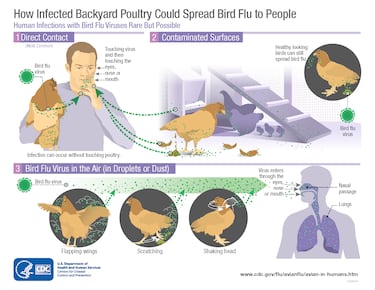Experts warn about the new H5N9 bird flu affecting California: How is it different from H5N1?
The first outbreak of H5N9 bird flu in poultry has been reported in California on a duck farm leading to the culling of nearly 119,000 birds and concerns.

A strain H5N9 of highly pathogenic avian influenza (HPAI), commonly called bird flu, has been detected for the first time in US poultry. The World Organisation for Animal Health (WOAH) said on Monday that US authorities at the Department of Agriculture also detected the more common H5N1 strain the same duck farm in Merced County, California.
Nearly 119,000 birds had been culled by December 2 to control the spread of bird flu which has been spreading around the globe in recent years. So far, hundreds of millions of poultry including chickens and turkeys have been culled leading to a shortage of eggs in the United States.
The disease has also infected to dozens of mammals, including dairy cows and pets in the United States as resulted in 67 confirmed infections in humans and associated with one death according to data on the H5 bird flu from the Center for Disease Control and Prevention (CDC).
How H5N9 is different from H5N1
The H5N9 strain has been detected before in North America among wild birds over the past two years. The strain was even detected in turkeys in Wisconsin in the 1960s, the earliest recorded infections from the strain, reports CBS News. Authorities at the time reported the infected bird had “mild respiratory symptoms and a severe drop in egg production.” The newly discovered strain is more causes more severe disease and “clinical signs included increased mortality,” said the USDA.
As for humans, infection from bird flu, while possible, is quite rare and with the exception of two cases, whose source is unknown, all others have been in people in close proximity to infected animals. Both the more prevalent H5N1 and the rarer H5N9 strains need to gain some key mutations in order to efficiently spread among humans.
“The seasonal, human H1N1 virus has an NA protein that is related, but different from the bovine H5N1 NA protein. There is some cross-recognition of avian H5N1 NA in the human population because of this,” Andy Pekosz, professor of microbiology and immunology at Johns Hopkins University told CBS News. However, people could potentially have less immunity to the H5N9 strain were it to gain a foothold in humans.
Fortunately, the H5N9 strain, in the few previous times that it has managed to cause severe disease in ducks has resulted in dead ends for it. “So far, I have not heard of any evidence to say this H5N9 has some kind of fitness that is better than the H5N1,” said David Swayne, a private veterinarian and former director of the USDA’s Southeast Poultry Research Laboratory. “If it doesn’t have that, it can’t outcompete.”
What is bird flu?
According to the Centers for Disease Control and Prevention (CDC), there are four types of influenza (flu) viruses: A, B, C, and D.
In the case of influenza type A, it is classified into multiple subtypes or strains according to two proteins on the surface of the virus. These subtypes are composed of a letter H and a number, a letter N and a number, or both pairs.
In the case of avian flu, it is an illness caused by infection with the type A avian influenza (flu) virus. According to the CDC, these avian influenza viruses are found naturally among wild waterfowl around the world and can infect domestic poultry, other birds and other animal species.
Not all strains infect people. The influenza A virus subtypes currently detected in people are the H1N1 and H3N2 strains.
How is bird flu transmitted?
Although infection in a human is rare, avian influenza viruses can be transmitted from infected birds to humans in several ways, according to the CDC: Directly from infected birds or from environments contaminated with avian influenza A viruses or through an intermediate host organism, such as another animal.

According to the CDC, infections in humans can occur when “enough of the virus enters a person’s eyes, nose, or mouth, or when the person breathes it in.” People who have prolonged unprotected contact with infected birds or places contaminated by their mucous membranes, saliva or feces could be at greater risk of infection.
Bird flu symptoms
Reported symptoms of avian influenza virus infections in humans have ranged from asymptomatic to mild cases, such as redness of the eyes (conjunctivitis) or mild upper respiratory tract symptoms similar to of influenza, even severe cases, such as pneumonia requiring hospitalization.
In severe cases, symptoms include fever (temperature of 100ºF [37.8ºC] or higher), cough, sore throat, runny nose, muscle or body aches, headache, fatigue, and shortness of breath or difficulty breathing. Less common signs and symptoms include diarrhea, nausea, vomiting, or seizures.
For more details about bird flu, go to the official website of the Centers for Disease Control and Prevention (CDC), where you will find information in English and Spanish.
Related stories
Get your game on! Whether you’re into NFL touchdowns, NBA buzzer-beaters, world-class soccer goals, or MLB home runs, our app has it all.
Dive into live coverage, expert insights, breaking news, exclusive videos, and more – plus, stay updated on the latest in current affairs and entertainment. Download now for all-access coverage, right at your fingertips – anytime, anywhere.
